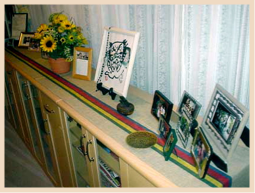
Todd Jay Leonard, Blog


Sometimes when Japanese people visit my home, they scratch their heads with puzzlement when they see how I have incorporated everyday Japanese objects as interior decorating accents ... and in completely different ways than the intended, original use.
A used sake barrel, for instance, makes a very nice end table once a piece of glass is laid on top of it. It is just the right height, wrapped in a decorative straw cover, with the brewer's name and logo colorfully painted all over it. These are normally discarded after they are opened.
People who arrive at my home in Japan are greeted by a smiling figure of Kintaro (a popular character in Japanese folklore) peering out of the window. From outside, everyone thinks that it is stained glass, but in fact it is a traditional banner I have hanging in my stairway that goes from the second-floor ceiling all the way to the bottom landing of the stairs.
His face just happens to be positioned in the window when viewed from outside, but from inside, it is a stunning interior accent that is normally used only during festivals. Also, as guests climb my stairs, I have a child's kimono hanging on the wall. It is 100 percent silk with an embroidered scene of a warrior in full armor.
A beautiful "obi" (kimono sash) adorns the top of a long cabinet I have in my upstairs hallway. The width is perfect, and of course, the fabric is exquisite. When older ladies visiting my home realize it is a kimono's obi, they are usually shocked, then fascinated in how it is being utilized. Again, few if any Japanese would use what they consider to be clothing as decorative objects.
Recently, I purchased an obi that I will use in my home in Shelbyville. My idea is to drape it on a long rod near the ceiling in such a way that shows not only the embroidered side, but also the plain side. To my eyes, the plain side is as beautiful as the decorative side.
There is a local shop here where I always take friends and family who visit me. The owner is accustomed to my frequently bringing a gaggle of foreigners in to browse around her constantly changing stock. It is a recycle shop for Japanese kimonos and accessories.
I am sure she is amused by the types of articles we buy, wondering how we can possibly wear them. Unbeknownst to her, no one ever intends to wear the items; some of the kimonos will be hung in living rooms, some obis used in dining rooms as table runners, others cut up and made into pillow covers.
When my cousins visited from Indiana, we went to her shop and bought several items. Once they returned home, they decided they really wanted a beautiful, white wedding kimono that she had displayed. So, I went back to the shop. Amazingly, it was still there, so I proceeded to purchase it.
She was quite confused as to why I was buying a woman's wedding kimono. She did remember my cousins and how enamored they were with this item, so I told her that it was for them, and that they wanted it to display in their home as a wall-hanging. I am sure she had a difficult time envisioning how a wedding kimono could be hung on a wall; in her mind's eye, it would look quite out of place. Everywhere I look, though, I see a potential interior object.
In Japan, once a month, we have a "sodai gomi" day which is for discarding large trash items. I know that some foreigners in big cities get up very early to ride their bikes up and down the narrow streets to see what items have been thrown out. Often, a nice antique piece of furniture can be found in the pile of trash. One person's trash is certainly another person's treasure.
Japanese people don't have the custom of having garage or rummage sales to get rid of unwanted items. If the item can't be sold to a recycle shop, often people will throw out perfectly good things on sodai gomi day.
I certainly am guilty of doing this. I always ask around to see if a neighbor or student may want the item I no longer need, but normally I have to carry it down to the trash heap because no one I know wants it.
In the past few years, perhaps due to the bad economy that has plagued Japan for the past decade and a half, there has been an interest in selling used items at flea markets (called "free" markets here). The city will sponsor these throughout the year, and people can reserve a space and sell items they no longer need. Popular among young people is clothing.
A teacher-friend of mine once gave a "furoshiki" to my mother as a gift. This is a traditional square cloth that is used to wrap and carry items. It is used like a bag. The patterns on these are quite stunning; some are made of silk, others cotton, and yet some are synthetic. They are exclusively used here to carry things.
When I told my teacher-friend that my mother liked it so much that she decided to wear it as a scarf, the look of horror on her face was priceless. People use these to elegantly carry objects from one place to another--never wear them.
A Japanese woman would never wear one around her neck, because people would think she was touched in the head. It would be akin to an American woman wearing a Wal-Mart bag on her head--something that might happen if she is caught in a deluge without an umbrella and needs to dart from the car to the house, but never as a fashion statement ... or at least I hope not.
By TODD JAY LEONARD
Columnist
Traditional Japanese objects serve as decorations
Monday, April 10, 2006







